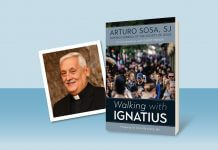
Yesterday was the first day of classes at Boston College. I love this time of year, and I love teaching at a Jesuit school (no matter what the ranking, which as we all should know should matter very little as long as we are working toward God’s greater glory). I was reminded of this love when, in my freshman seminar in the Western Cultural Tradition (the first in a sequence in BC’s Honors Program), I began telling the story of the Jesuits’ entrance into education. It was at Messina, Sicily– some citizens had petitioned Ignatius to start a school, and he sent ten of his best men (including Peter Canisius and Jeronimo Nadal). That opportunity telescoped into a global mission. (See some of the members of that worldwide family of schools here.)
One of the remarkable elements of Jesuit education was that it was built upon a bedrock of Renaissance humanism. (See Ronald Modras’ fine book Ignatian Humanism: A Dynamic Spirituality for the Twenty-first Century.) The basic theological principle was this: whatever helps us understand what it means to be human also helps us understand God. It is a theology rooted in Ignatius’s experience of the spiritual exercises, inasmuch as the exercises are about coming to know the God who has created us out of love and who can be discerned in the entirety of creation– “God in all things.”
Ours is an age of fractiousness and balkanization. Jesuit education has stood for some 450 years as a sign that all inquiry can be a holy pursuit, be it literary or scientific or philosophical or anything else. If there is a “cardinal sin” in the enterprise of education, it is the unwillingness to raise or attempt to answer hard questions– a point underscored by the influential Jesuit philosopher Bernard Lonergan. The problem in colleges in universities today is not a lack of passion, or a lack of faith, or some kind of Marxist-Freudian-postcolonial-feminist-deconstructive conspiracy. It is rather a lack of integration, of people no longer willing (or encouraged) to cross narrow disciplinary boundaries, to venture, missionary-like, to answer the basic questions: why are we here? how shall we live? what is love? why is there evil?
The Jesuits had the remarkable idea that Cicero could help us answer these questions, as could Homer, Sophocles, Horace, and Livy, along with Matthew, Mark, Luke, John, and Paul. Theirs was and is an expansive view. Today, we might add that the likes of Marx and Darwin, Freud and Nietzsche, Sartre and Beauvoir, Kong Zi (Confucius) and Ibn Rushd (Averroes), and many more. I think of the language of the Vatican II document on world religions, Nostra Aetate, which caught up to the Jesuits’ forward thinking: “the Catholic Church rejects nothing that is true and holy in these religions” (paragraph 2). Religion (Latin ligare, to bind) is that which has a hold on the way we look at the world, and so the religions that are Marxism, Darwinism, Freudianism, existentialism, feminism, Taoism, Islam, Buddhism, and so on all can teach us something about what it means to be a human being. And they are all welcome at my seminar table (though, admittedly, some I find more fruitful than others), as long as we all agree to deal with our questions in humility and honesty.
But there is one further point– a gift, really, that Jesuit schools need to offer to the world. In a world where pluralism is the norm, words often are more heat than light, hatred erupts amidst the burning of sacred books, misunderstanding is preached for the sake of market share, and bias seethes underneath the veneer of civility, Jesuit schools can point to Jesus. They can invite an encounter with Jesus in classes, in art, in theater, in service programs, in liturgies, in the examples of people energized by the spiritual exercises. Far from a retreat into a sectarian enclave, the experience of the spiritual exercises can open one in friendship to a world where God breathes everywhere, with “warm breast and with ah! bright wings.”




![World Union of Jesuit Alumni Congress James Davis Garden at John Carroll University [provided by JCU for Picturing God]](https://www.ignatianspirituality.com/wp-content/uploads/2017/05/JCU-James-Davis-Garden-675-218x150.jpg)
Clementplace,
What you’re describing Ignatius calls “composition of place” in the Spiritual Exercises. It’s a technique of putting ourselves within an imaginative space in prayer, and it has a long history in Ignatian spirituality. For a treatment of this idea, see Nicholas Standaert, SJ, “Composition of Place,” an article from the British Jesuit journal The Way, at http://www.theway.org.uk/Standaert.pdf.
As for re-enacting the Last supper, the theological term is “anamnesis,” a Greek word that means “remembrance.” There’s a good little article about it here: http://www.saintanthonygroton.org/quest/mass.htm.
Hi Tim
Thanks for your insights into the philosophy underpinning the Jesuit approach to education. I have benefitted enormously from it myself (BC also!), and I am now discovering the many wonderful websites the Jesuits have out there, providing much food for “hungry” travellers. Presently reading your book, “The Ignatian workout” – great stuff! Keep writing!
hey Tim, can you answer above question?
thnks
I like how the Jesuits teach spiritual techniques to apply in your own world. There are two techniques which I practice.
The first one is the examen, which is powerful since it attenuates the positive, where do we see God during the day. I get alot out of this.
The second technique I like (and my question) is to place yourself in an event, like on the shore with fisherman while Jesus is in the boat teaching, your actually there – what is this technique called and where is it described, if at all, on your web site?
I have tried this at Mass, placing yourself at the alter, when the priest describes the events at the Last Supper. Would you consider this correct, are we re-enacting the Last Supper at Mass?
Thanks,
[…] Ignatian education It is a theology rooted in Ignatius's experience of the spiritual exercises inasmuch as the exercises are about coming to know the God who has created us out of love and who can be discerned in the entirety of creation– “God in all . […]